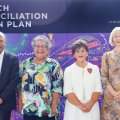The University of Queensland has become the first organisation in the southern hemisphere and one of the first internationally to gain access to the world's only Low Earth Orbit Satellite system, launched in northern Russia on February 15.
The University's Department of Electrical and Computer Engineering has signed a Memorandum of Understanding (MOU) with the Russian Space Agency to access the GONETS system of six operational spacecraft.
Department lecturer Dr Mikhail Cherniakov, formerly a professor of communications at Moscow University, negotiated the MOU on behalf of the University, only five days after the launch.
Dr Cherniakov said the MOU gave the University a significant advantage over other universities and commercial companies as it guaranteed access to an actual operational system.
He said the Russian space agency was keen to work with a southern hemisphere partner, and the University of Queensland's Wireless Communications Group had a strong record of achievement and innovation in the satellite communication field.
The University research group has already produced many breakthroughs in wireless and satellite communications, including vehicle-mounted and briefcase antenna systems for operation with the Australian geostationary satellite system, Mobilesat.
'The University of Queensland is better placed than any other Australian university to develop expertise in this new Low Earth Orbit Satellite (LEOS) system technology to support industry,' he said.
The University's research using the LEOS system will focus on further improvements in mobile communications, particularly extending mobile telephone coverage.
Dr Cherniakov said in the past few years the number of mobile communications users had increased dramatically. In particular, the number of mobile phone users worldwide had exploded. These users, however, had been limited by the coverage of the mobile service providers in their areas.
'Australia, with its sparse population, feels this limitation with vast areas lacking coverage,' he said.
'The solution to this problem in rural Australia has been to employ the MobileSat system where clients with specialised equipment use satellites in geostationary orbit to connect to the telephone system.
'Unfortunately, this system and the equipment used are costly. The relatively high power levels required preclude the use of a handset-style telephone; instead, car-mounted or similar telephones are required.
'LEOS systems may provide an answer to many, if not all, these difficulties. LEOS systems use an extensive network of small satellites moving around the earth, at an orbit relatively close to the Earth's surface. These smaller satellites are cheaper to manufacture and to launch, and their lower proximity to the Earth means that less power is required and so smaller, lighter and cheaper handsets can be used.'
Dr Cherniakov said recent research and new methods in mobile telephony meant it was becoming practical to have a single handset to use the existing cellular network when the user was in range, and then switch automatically to a LEOS system when service was lost.
In addition to global and regional voice communications, LEOS systems are set to offer two-way data messaging. This could be used for a variety of services such as personal paging, weather reports, low-rate transmission for Internet connection, fax communication and radio positioning similar to the GPS (Global Positioning System). The GPS system is currently used on boats and aircraft, enabling users to determine their positions in the world to within a few metres.
Dr Cherniakov said the Wireless Communication Group was developing an interest in LEOS systems with the signing of the MOU.
'A small research grant has been made to investigate the development of an adaptive, or smart, array antenna system for use on LEOS handsets,' he said.
Research group leader Associate Professor Marek Bialkowski and Dr Cherniakov have submitted an application for a larger research grant and commercial partners are being sought for several other LEOS projects. These include networking in LEOS, investigations of the LEOS electromagnetic environment and the development of protocols for a universal terrestrial wireless and LEOS network.
'Our immediate research aims to solve the multi-path propagation problems inherent to these systems,' Dr Bialkowski said.
'One of the most common problems in mobile telephone reception is multi-path fading. This occurs when the signal from the base-station transmitter is received twice, once from direct transmission and then again from copies of the signal that have bounced off features of the landscape such as hills or buildings. These two received signals are slightly different and interfere with each other causing the signal to be lost.
'A fundamental difference with the new project is that in geostationary systems, such as the Australian Mobilesat, the satellite is seen at a high elevation angle, so the multi-path propagation effects are not as important.
'With LEOS systems, the average elevation angle at which an orbiting satellite is seen is approximately 17 degrees. In this case, the multi-path propagation effect could seriously affect the communication link unless some methods of overcoming this problem are introduced. One of the very effficient remedies is an adaptive array antenna system which can make a choice between different incoming signals. An ordinary antenna system combines direct and reflected signals which often can be out of phase. This leads to the signal fading and to degradation of the communication quality.'
Dr Cherniakov said adaptive array antennas, in effect, received only in the direction of the best signal. They ignored the reflected signals, reducing multi-path problems.
With current concerns about mobile telephone radiation, adaptive arrays were able to reduce necessary energy from the handset while selecting the strongest incoming signal, minimising any possible health risks. The group is approaching this problem from two directions - new antenna systems and improved digital signal processing techniques.
For further information about commercialisation opportunities contact Gary Heyden, (telephone 3365 3803) or Jack Hennessy (telephone 3365 7477) at UniQuest Limited, the University's technology transfer company.
For further information contact Dr Bialkowski telephone 3365 3563, Dr Cherniakov telephone 3365 4139 or the Microwave Group laboratory manager Ray Whitehead telephone 3365 3569.



